This site is Blackburn’s former general post office, typical of the grand, Edwardian post offices built in the early 1900s.
A print and text about Rowland Hill and the post office.
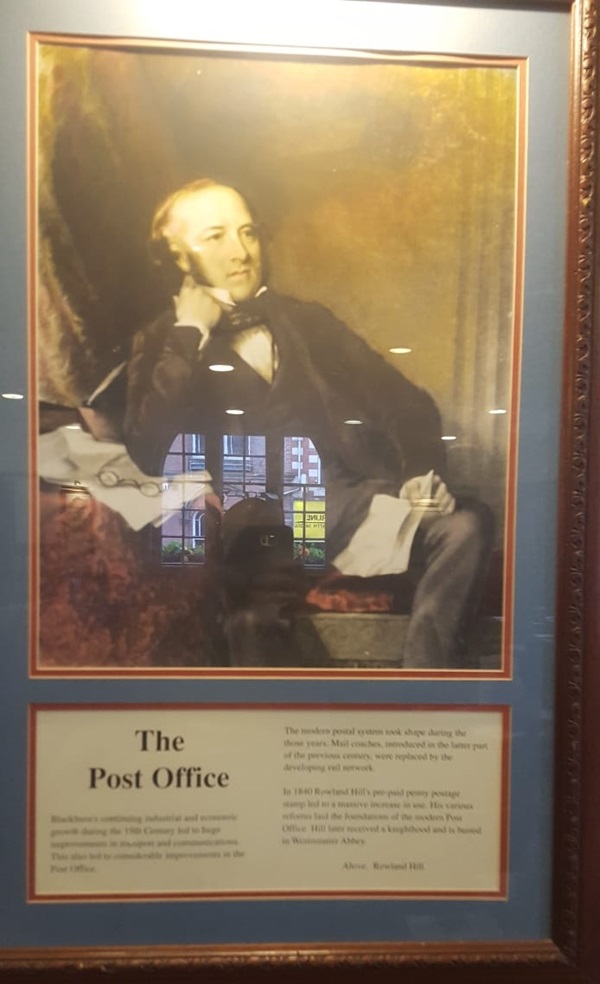
The text reads: Blackburn’s continuing industrial and economic growth during the 19th century led to huge improvements in transport and communications. This also led to considerable improvements in the post office.
The modern postal system took shape during those years. Mail coaches, introduced in the latter part of the previous century, were replaced by the developing rail network.
In 1840 Roland Hill’s re-paid penny postage stamp led to a massive increase in use. His various reforms laid the foundations for the modern post office. Hill later received a knighthood and is buried in Westminster Abbey.
Above: Rowland Hill.
Prints and text about buses and trams.
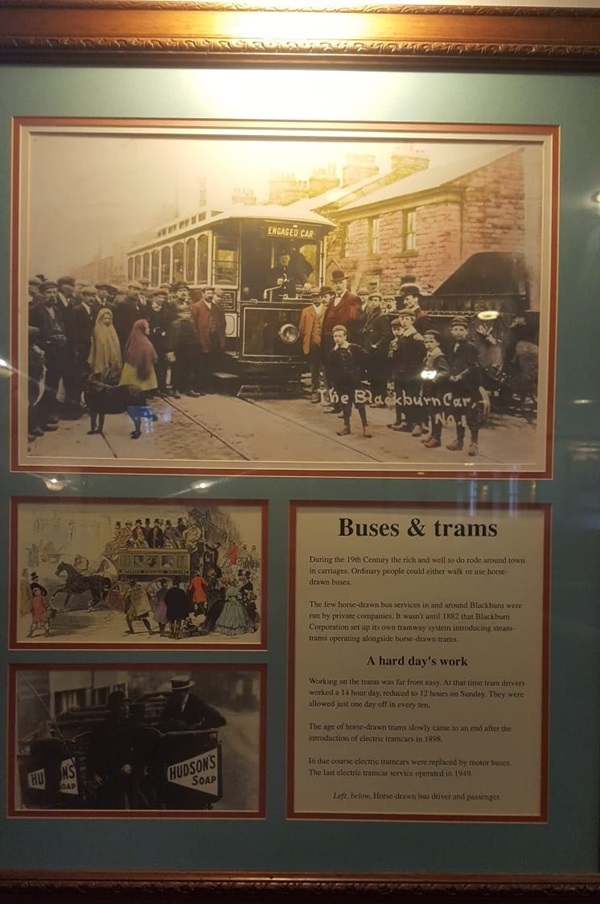
The text reads: During the 19th century the rich and well to do rode around town in carriages. Ordinary people could either walk or use horse-drawn buses.
The few horse-drawn bus services in and around Blackburn were run by private companies. It wasn’t until 1882 that Blackburn Corporation set up its own tramway system introducing steam-trains operating alongside horse-drawn trams.
Working on the trams was far from easy. At that time tram drivers worked a 14 hour day, reduced to 12 hours on Sunday. They were allowed just one day off in every ten.
The age old horse-drawn trams slowly came to an end after the introduction of electric tramcars in 1891.
In due course electric tramcars were replaced by motor basics. The last electric tramcar service operated in 1949.
Left, below, Horse-drawn bus driver and passenger.
A photograph and text about Kathleen Ferrier.
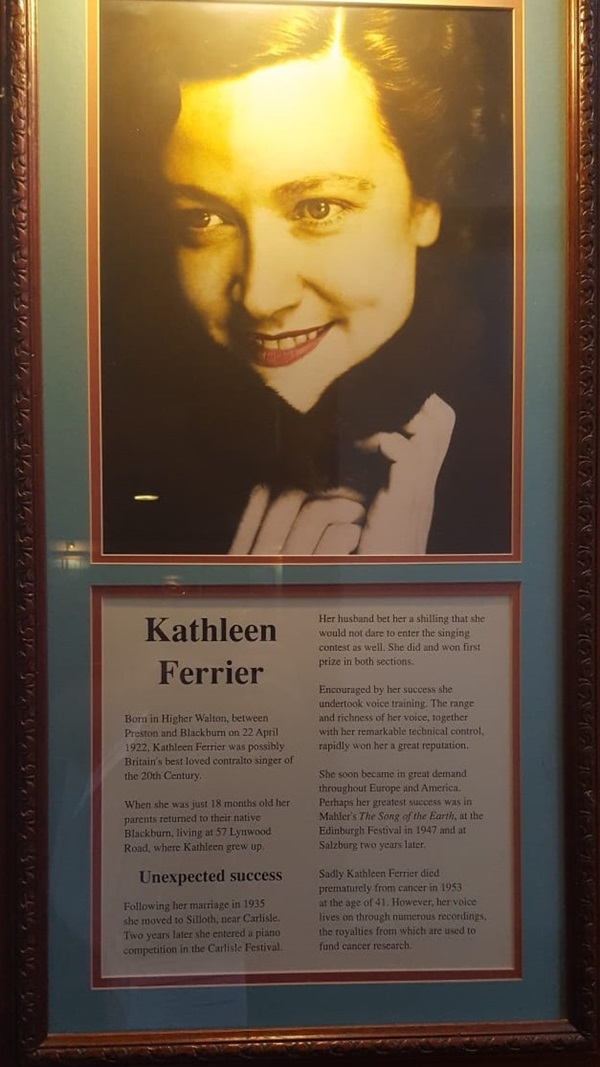
The text reads: Born in Higher Walton, between Preston and Blackburn on 22 April 1922, Kathleen Ferrier was possibly Britain’s best-loved contralto singer of the 20th century.
When she was just 18 months old her parents returned to their native Blackburn, living at 57 Lynwood Road, where Kathleen grew up.
Following her marriage in 1935, she moved to Silloth, near Carlisle. Two years later she entered a piano competition in the Carlisle Festival.
Her husband bet her a shilling that she would not dare to enter the singing contest as well. She did and won first prize in both sections.
Encouraged by her success, she undertook voice training. The range and richness of her voice, together with her remarkable technical control, rapidly won her a great reputation.
She soon became in great demand throughout Europe and American. Perhaps her greatest success was in Mahler’s The Song of the Earth, at the Edinburgh Festival in 1947 and at Salzburg two years later.
Sadly Kathleen Ferrier died prematurely from cancer in 1953 at the age of 41. However, her voice lives on through numerous recordings, the royalties from which hare used to fund cancer research.
Prints and text about local traders.
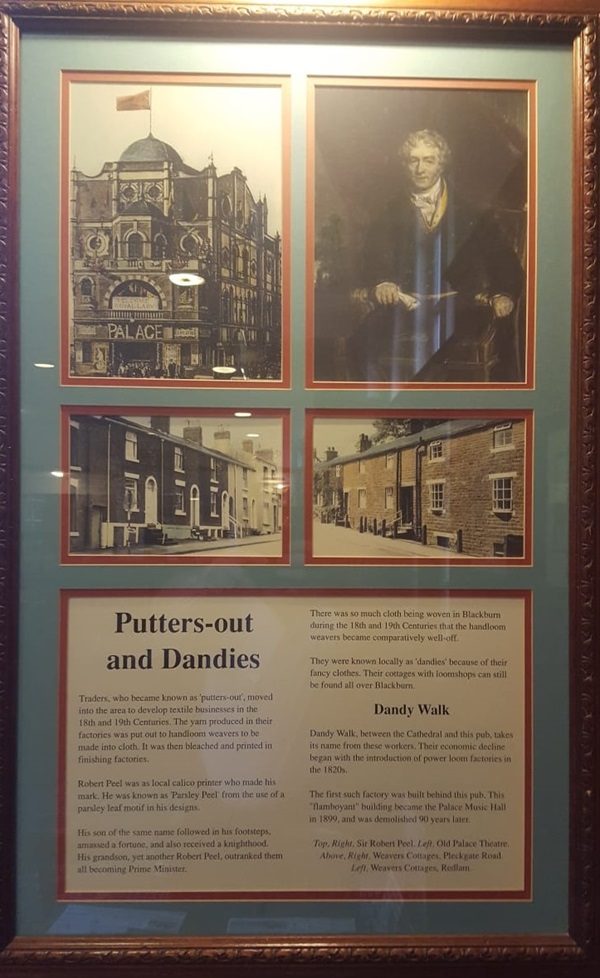
The text reads: Traders, who became known as ’putters-out’, moved into the area to develop textile business in the 18th and 19th centuries. The yarn produced in their factories was put out to handloom weavers to be made into cloth. It was then bleached and printed in finishing factories.
Robert Peel was as local calico printer who made his mark. He was known as ‘Parsley Pell’ from the use of a parsley leaf motif in his designs.
His son of the same name followed in his footsteps amassed a fortune, and also received a knighthood. His grandson, yet another Robert Peel, outranked them all becoming prime minster.
There was so much cloth being woven in Blackburn during the18th and 19th centuries that the handloom weavers became comparatively well-off.
They were known locally as ‘dandies’ because of their fancy clothes. Their cottages with loom shops can still be found all over Blackburn.
Dandy Walk, between the Catholic and this pub, takes its name from these workers. Their economic decline began with the introduction of power loom factories in the 1820s.
The first such factory was built behind this pub. This “flamboyant” building became the Palace Music Hall in 1899, and was demolished 90 years later.
Top, right, Sir Robert Peel, left old Palace Theatre. Above, right, Weavers Cottages, Pleckgate Road.
Left, Weavers Cottages, Redlam.
Prints and text about law and order.
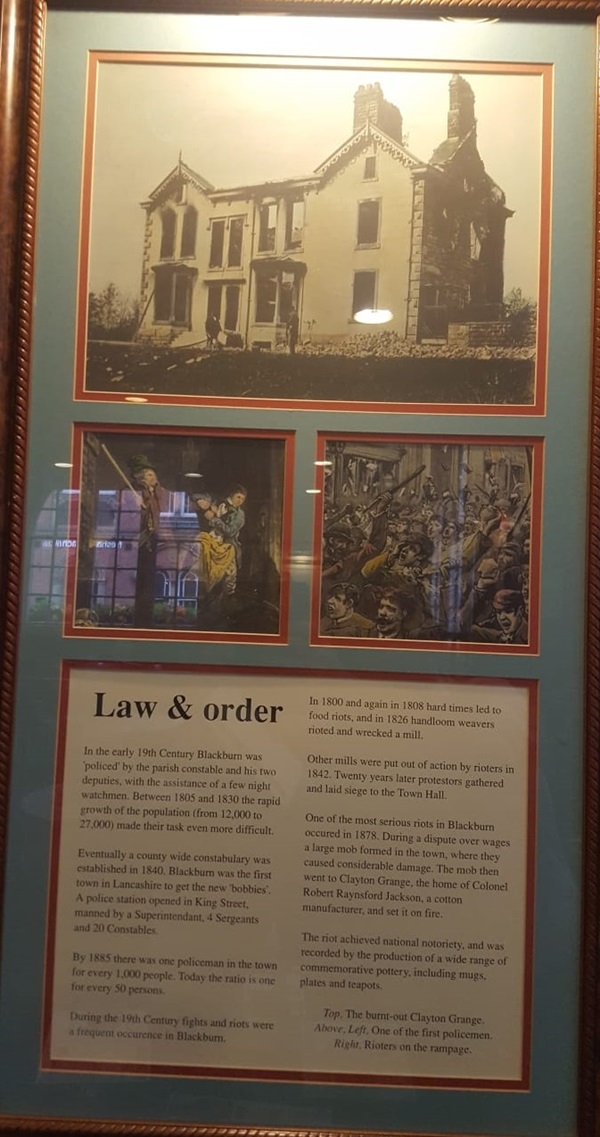
The text reads: In the early 19th century Blackburn was ‘policed’ by the parish constable and his two deputies, with the assistance of a few night watchmen. Between 1805 and 1830 the rapid growth of the population (from 12,000 to 27,000) made their task even more difficult.
Eventually a county wide constabulary was established in 1840. Blackburn was the first town in Lancashire to get the new ‘bobbies’. A police station opened in King Street, manned by a superintendent, 4 sergeants and 20 constables.
By 1885 there was one policeman in the town for every 1,000 people. Today the ratio is one for every 50 persons.
During the 19th century fights and riots were a frequent occurrence in Blackburn.
In 1800 and again in 1808 hard times led to food riots, and in 1826 handloom weavers rioted and wrecked a mill.
Other mills were put out of action by rioters in 1842. Twenty years later protestors gathered and laid siege to the Town Hall.
One of the most serious riots in Blackburn occurred in 1978, during a dispute over wages a large mob formed in the town, where they caused considerable damage. The mob then went to Clayton Grange, the home of Colonel Robert Raynsford Jackson, a cotton manufacturer, and set it on fire.
The riot achieved national notoriety, and was recorded by the production of a wide range of commemorative pottery, including mugs, plates and teapots.
Top: The burnt-out Clayton Grange
Above, left one of the first policemen, right, rioters on the rampage.
Prints and text about the cathedral.
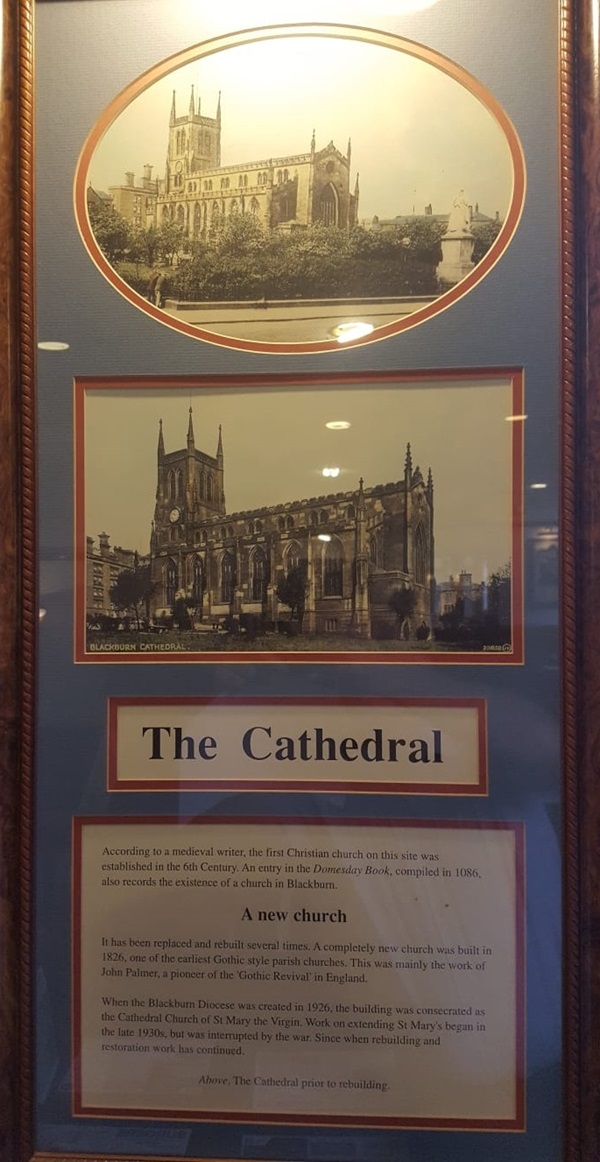
The text reads: According to a medieval writer, the first Christian church on this site was established in the 6th century. An entry in the Domesday Book, compiled in 1086, also records the existence of a church in Blackburn.
It has been replaced and rebuilt several times. A completely new church was built in 1826, one of the earliest Gothic style parish churches. This was mainly the work of John Palmer, a pioneer of the ‘Gothic Revival’ in England.
When the Blackburn Diocese was created in 1926, the building was consecrated as the Cathedral Church of St Mary the Virgin. Work on extending St Mary’s began in the late 1930s, but was interrupted by the war. Since when rebuilding and restoration work has continued.
Above: The cathedral prior to rebuilding.
Prints and text about the local church and school.
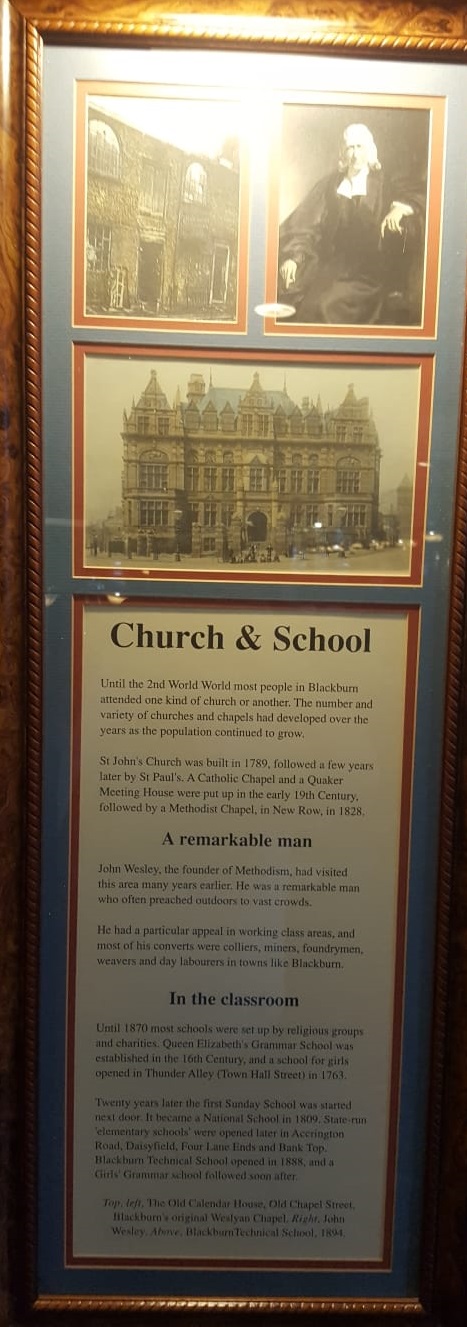
The text reads: Until the 2nd World War most people in Blackburn attended one kind of church or another. The number and variety of churches and chapels had developed over the years as the population continued to grow.
St John’s Church was built in 1789, followed a few years later by St Paul’s. A Catholic Chapel and a Quaker Meeting House were put up in the early 19th Century, followed by a Methodist Chapel, in New Row, in 1828.
Until 1870 most schools were set up by religious groups and charities. Queen Elizabeth’s Grammar School was established in the 16th century, and a school for girls opened in Thunder Alley (Town Hall Street) in 1763.
Twenty years later the first Sunday School was started next door. It became a National School in 1809. State-run ‘elementary schools’ were opened later in Accrington Road, Daisyfield. Four Lane Ends and Bank Top. Blackburn Technical School opened in 1888, and a Girls’ Grammar school followed soon after.
Top, left, The Old Calendar House, Old Chapel Street, Blackburn’s original Weslyan Chapel, right John Wesley, above, Blackburn Technical School, 1894.
A sculpture of a post box, inspired by the pub’s former use.
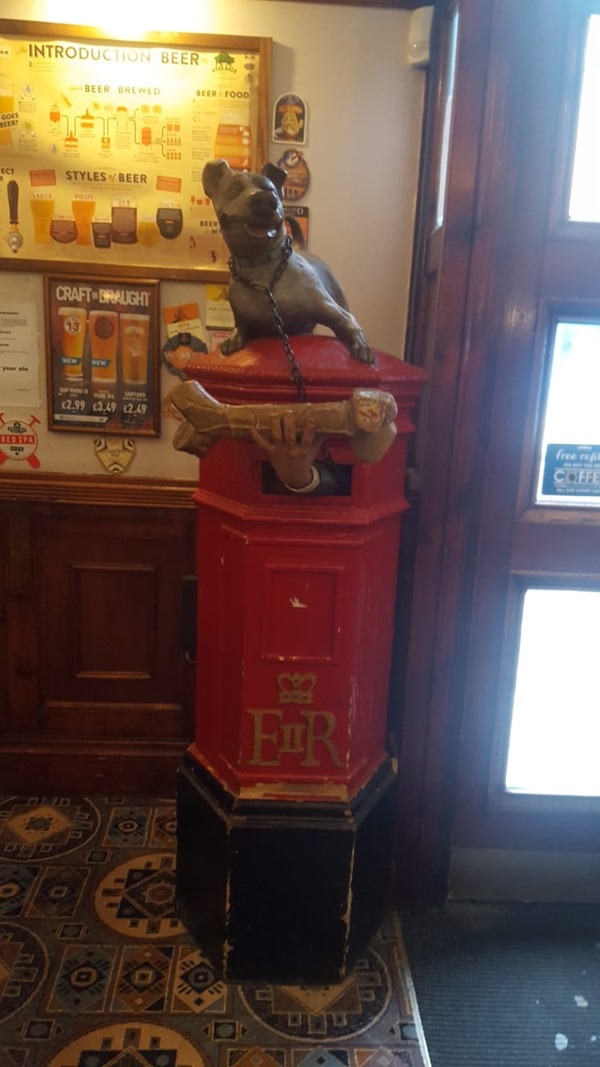
External photograph of the building – main entrance.
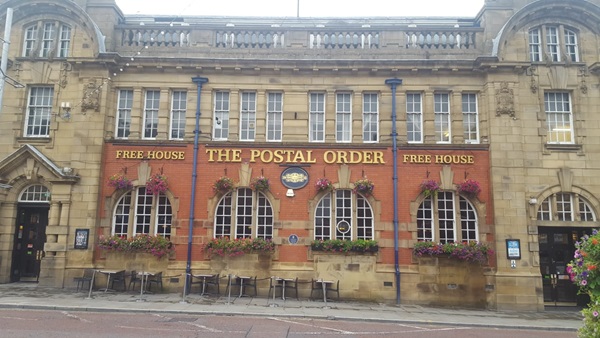
If you have information on the history of this pub, then we’d like you to share it with us. Please e-mail all information to: pubhistories@jdwetherspoon.co.uk